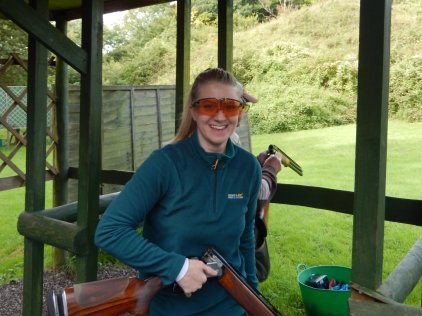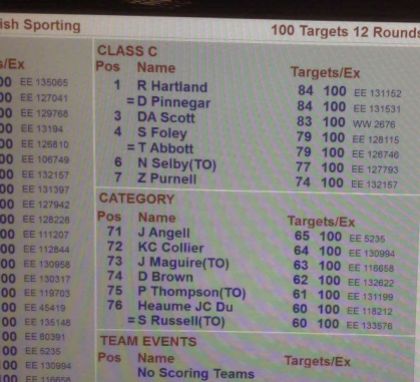July 1st 2015. It was the hottest day of the year so far, and I was a complete bag of nerves. We pulled up into the car park at Ian Coley’s Shooting School and I reminded myself ‘it really doesn’t matter about the score, just try to enjoy it. Be safe, be polite and try to emulate anything you see that works for others’.

This was my first registered CPSA competition, and although I’d only picked up a shotgun for the first time less than 2 years earlier, I was determined to try the ‘registered scene’ out. I’d been along to a few competitions to watch Joe, and I was fascinated by it. I’d never been competitive before, and aside from the odd netball match at school I hadn’t really considered myself as being ‘sporty’ or passionate about a hobby. But after my first experience of clay shooting some sort of competitive spirit had stirred within me.
We got our kit together and checked in at the front desk. Joe, his father and I were put into a squad with 3 other shooters (more about squads shortly) and we were taken around by our referee who was Shaun Porter, Head Instructor at Ian Coley’s. My knees were trembling, and I remember wishing that I was wearing trousers rather than shorts so that people couldn’t see my legs shake! Everyone in my squad was very kind and friendly; especially when they found out it was my first ever competition.
I knew that there would be some target presentations that I had never seen before, but my aim was to hit as many of the ‘easier’ clays that I could and if I managed to hit any of the more testing targets, well that would just be a bonus. Joe had told me that as a complete beginner I should aim for a score of between 30-40%. He told me that he knew I could hit more in a practice session, but the adrenaline and the new sensory environment would make it harder for me to gain a better score. He was right about it feeling very different; I was excited, nervous and to top it off I was hot from the blazing sun! It took me a few stands to settle in, but I began to really enjoy myself.

Hitting some of those clays that day made me feel incredibly proud. I knew that I wasn’t anywhere near the same standard, or hitting as many clays as everyone else, but I didn’t care because here I was taking myself completely out of my comfort zone and absolutely loving it. As we finished, Shaun told us all our scores. With a big grin, he turned to me and said “Very well done Zea, you’ve scored 50%” I was gobsmacked; I had no idea that I’d hit that many targets! And that was it then, I was hooked!

The next competition I entered was a few days later at Longridge Shooting Ground run by Stephen Nutbeam and amazingly I got an even better score! That’s not to say it continued in that way. As every shooter will tell you there are good days and there are bad days in competitions, but the most important thing is to remember to enjoy yourself and to keep on learning!

So, you’d like to try out a registered competition yourself. But perhaps you don’t know what to expect. Here’s a few pointers;
What is Targets Only/Birds Only?
If you want to enter a CPSA competition and are not a member, you will automatically be entered as a ‘Targets Only’ (also known as ‘Birds Only’) competitor. This means you will only pay for the competition fee, and will not be eligible to win any prize money in class. Your score will not be entered anywhere other than on your score card.
If you are a CPSA member you have 2 choices – you can enter as Targets Only and again, won’t be entitled to prize money should you come 1st, 2nd or 3rd in your class, but your score will be recorded on the CPSA database. Or you can pay an extra levy to be put into the prize pot and the chance of winning some money back.
How much does it cost?
The fees can vary from ground to ground, but generally expect to pay around £30-£35 for Targets Only, and £40 for Competition. The £5 difference is what goes into the prize pot for 1st, 2nd and 3rd in class.
What kit will I need?
Other than your gun, you will need your own cartridges. Most Sporting competitions are 100 targets, but make sure you have enough extras in case you get ‘no birds’ (which means a clay either comes out of the trap broken or has a completely irregular flight path) I would suggest you take at least 125 cartridges on a 100 ESP competition.

Mandatory items for any CPSA registered shoot are shooting glasses and ear protection. On many grounds you will also be expected to wear a hat to protect you from any falling debris; small fragments of clay or lead shot.
Make sure you take a drink, and it’s wise to take a snack too. Shooting 100 targets can be really tiring so stay hydrated and keep your sugar levels steady.
A future post of ‘Kit List – The Shooting Essentials’ will go into greater depth of everything you will need for shooting
What is a squadded competition?
For the majority of competitions in English Sporting, you will move from stand to stand on your own and hand your card to the referee on each stand who will mark down your ‘kills’ and ‘losses’. But some grounds will put you into a squad. This is usually a group of approx. 6 shooters and you will be with this group of people, and with an instructor/referee for the whole competition. The etiquette is that you will shoot in rotation, so if you are the second person to shoot on a stand, you will then become the first person on the next stand. It is customary that the first person onto a stand gets to see a pair of targets before they shoot, but other shooters will not have the same on their turn as they will have already seen the targets.

Any tips or tricks?
- For your first few competitions, don’t set yourself any other goal than to enjoy yourself. Aim for a score between 20-40%. You may well hit more clays in a practice session, or at club level, but a registered competition is a very different atmosphere and you will be nervous.
- Focus on your familiar targets – don’t worry that you won’t know how to address some presentations as there will be a lot that you haven’t seen before. Instead try to ‘bank’ as many easier targets as you can. Anything else is a bonus!
- Consider ‘double barrelling’ the first clay if it is slow and close; there is nothing stopping you from firing two cartridges at the first target, although the second target will be sent anyway. If you hit it, at least you have achieved 50%. A tick on the card is better than a zero!
- Most of all, have fun!


